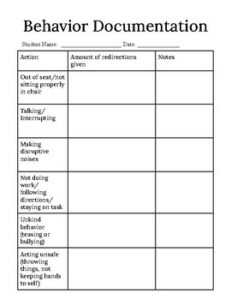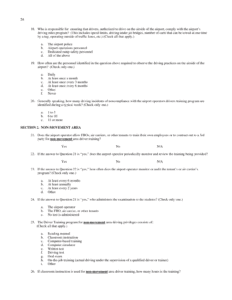Navigating the diverse behaviors in any classroom can be one of the most rewarding, yet challenging, aspects of education. From minor disruptions to more significant concerns, understanding why a student acts a certain way is crucial for fostering a positive learning environment. But how do educators keep track of these moments consistently and objectively, especially when juggling multiple responsibilities?
That’s where a structured approach comes in handy. Having a reliable method to document student actions, triggers, and responses can transform anecdotal observations into valuable data. A well-designed behavior log template for students isn’t just a record-keeping tool; it’s a foundational element for informed decision-making, effective intervention strategies, and ultimately, student growth.
Why a Behavior Log Template is Essential for Student Success
Imagine trying to understand a complex puzzle without all the pieces. That’s often what it feels like when addressing student behavior without a systematic way to track it. A behavior log template provides those missing pieces, offering a clear, objective record of events. It moves us beyond subjective feelings or vague memories, providing concrete data that illuminates patterns and helps us understand the “why” behind student actions. This objective data is invaluable for everyone involved in a student’s educational journey.
One of the primary benefits is the ability to identify triggers and antecedents. When you consistently log when and where specific behaviors occur, what happened immediately before, and who was involved, you start to see connections. Perhaps a student frequently acts out during unstructured group work, or a particular time of day consistently brings challenges. This detailed insight allows educators to proactively modify the environment or lesson plan to prevent issues before they even start, rather than just reacting to them.
Furthermore, a behavior log serves as an excellent tool for tracking progress and the effectiveness of interventions. You’ve implemented a new strategy, but how do you know if it’s working? Regular logging provides a baseline and then shows whether the frequency, intensity, or duration of a behavior is decreasing or increasing over time. This data empowers educators to adjust their approaches as needed, ensuring that the support provided is truly beneficial and tailored to the student’s evolving needs.
Beyond immediate classroom management, these logs are vital for facilitating clear and consistent communication. When discussing a student’s behavior with parents, other teachers, administrators, or support staff, having a detailed, objective record is far more impactful than relying on memory. It provides concrete examples, timelines, and information about interventions already attempted, fostering a collaborative approach based on facts, not just opinions. This ensures everyone is on the same page, working towards common goals with a shared understanding.
Finally, while primarily a tool for educators, the data gathered can, when appropriately shared and discussed, help foster self-awareness in students themselves. When a student sees patterns in their own behavior and the impact it has, it can be a powerful catalyst for change. It encourages them to take ownership of their actions and participate in developing strategies for improvement.
Key Elements to Include in Your Template
- Student’s Name and Identifying Information
- Date and Time of Observation
- Specific Behavior Observed (be objective, descriptive)
- Location Where Behavior Occurred
- Antecedent (What happened immediately before the behavior?)
- Consequence/Intervention Attempted (How was the behavior addressed?)
- Outcome of the Intervention
- Observer’s Name
- Severity or Frequency Rating (optional, but helpful)
Practical Tips for Effective Logging
- Be Objective: Stick to observable facts; avoid judgments or interpretations.
- Be Consistent: Log behaviors as soon as possible after they occur to ensure accuracy.
- Focus on Specific Actions: Instead of “student was disruptive,” write “student called out answers without raising hand 5 times in 10 minutes.”
- Avoid Overwhelm: Start with tracking a few key behaviors rather than trying to capture everything.
How to Implement and Use Your Behavior Log
Getting started with a new system might seem daunting, but implementing a behavior log can be streamlined with a clear plan. First, select or create a behavior log template that genuinely works for your environment. Consider whether you prefer a digital format for easy data analysis or a paper-based one for quick, on-the-spot notes. Once you have your template, ensure that anyone who will be using it understands its purpose and how to fill it out consistently. A brief training session or a clear set of guidelines can make a huge difference in data quality.
Daily use is where the rubber meets the road. The most effective logs are those that are filled out consistently and promptly. It’s not about waiting for a major incident; it’s about capturing the small, everyday occurrences that accumulate into patterns. Develop a habit, perhaps at the end of each class period or day, to quickly record observations. The goal is to make logging a seamless part of your routine, not an additional burden. Quick, factual notes are often more valuable than lengthy, retrospective accounts.
The real power of a behavior log for students emerges when you begin to analyze the data. Don’t just collect information; review it regularly. Look for trends across days, weeks, or even months. Are certain behaviors more prevalent on specific days of the week? During particular subjects? With certain peers? This analysis allows you to move from simply reacting to behaviors to proactively designing interventions that address the root causes. It helps you understand the bigger picture beyond isolated incidents.
Finally, using the log as a tool for discussion is perhaps its most crucial function. When you need to speak with a student, their parents, or other support staff about behavior, the log provides a foundation for a constructive conversation. Instead of saying, “Your child is often disruptive,” you can say, “I’ve noticed from our behavior log template that on three occasions this week, during independent work time, [student’s name] struggled to stay in their seat and finish their task. Here are the interventions we tried…” This objective, data-driven approach fosters collaboration and problem-solving, rather than blame, moving everyone towards a shared goal of supporting the student.
The systematic recording of student behaviors creates a robust framework for understanding, intervening, and ultimately guiding students toward more positive outcomes. It transforms challenges into opportunities for growth, ensuring that every student has the best possible chance to thrive in their learning environment. This thoughtful approach empowers educators and supports the holistic development of each individual, making the classroom a place where everyone feels understood and supported.



